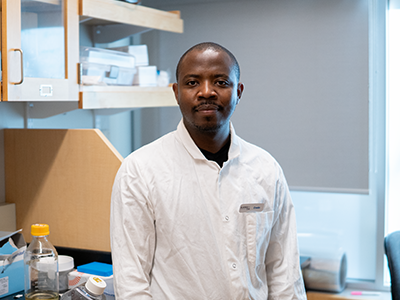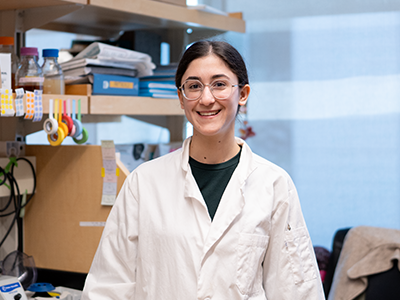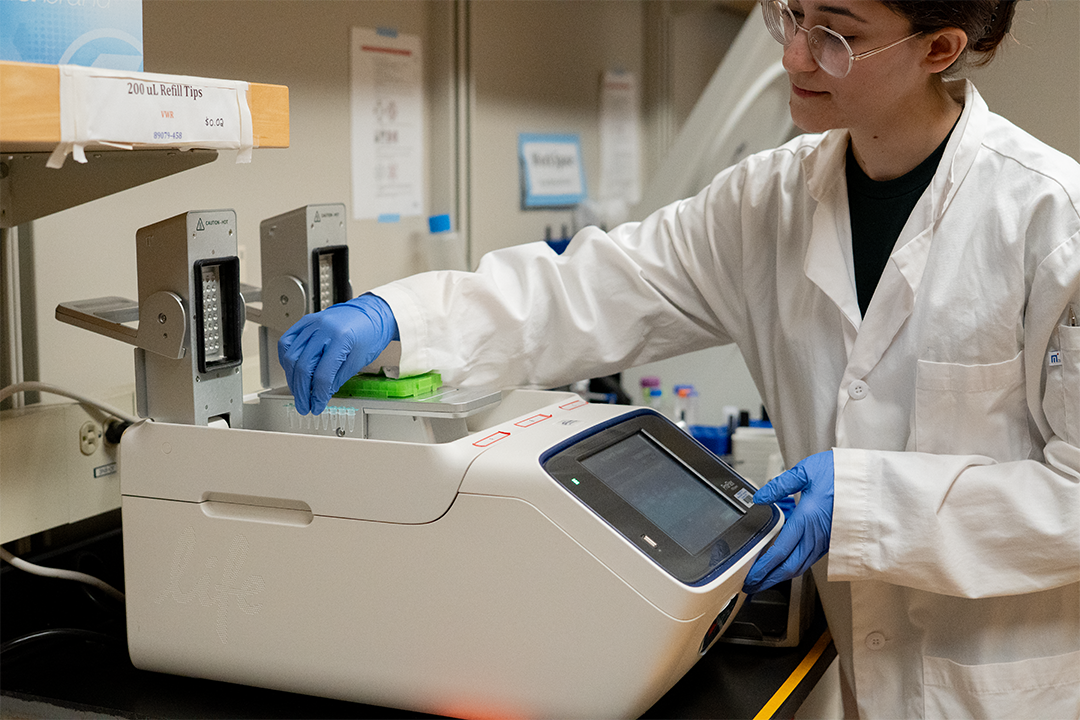Awards and recognition
Credo Casmil and Ayşe Erdoğan awarded 2024-2025 William and Dorothy Gilbert Scholarships
We are excited to congratulate Credo Casmil and Ayşe Erdoğan for receiving the 2024-2025 William and Dorothy Gilbert Scholarship in Biomedical Sciences. This award, established in 1995 by Professor Terrance Snutch in honour of William and Dorothy Gilbert, celebrates the accomplishments of outstanding doctoral students at the Michael Smith Laboratories. While this year’s recipients are focussing on research that spans from basic to applied science, both their projects are helping to advance understanding in critical areas of the biomedical field.

PhD candidate Credo Casmil
Credo Casmil (he/him) is a PhD candidate in our Genome Science and Technology Graduate Program, and carries out his research in the lab of Dr. Anna Blakney (MSL, School of Biomedical Engineering). Casmil completed his undergraduate degree at UBC in biochemistry, where he gained research experience in pharmaceutical sciences and yeast genomics.
“I had the opportunity to work with Dr. Eric Jan on his research in applied virology, which led to learning more about the work done in the Blakney lab,” shares Casmil. “During the COVID-19 pandemic when vaccines were just rolling out, this really caught my interest and led to me pursuing my graduate studies here.”
Casmil’s current work is focussed on self-amplifying (sa)RNA for applications in vaccination. A twist on the more well-known mRNA used in many COVID-19 vaccines, saRNA can enter cells and ‘amplify’ itself, lowering the dose needed to vaccinate against a disease.
saRNA is made by taking the RNA of specific viruses, and replacing the segments that code for structural proteins with sequences that code for proteins needed for vaccination. The saRNA is able to take advantage of the natural processes viruses have for replicating themselves to then do the same.

When discussing his specific project, Casmil highlights, “currently in the field only three types of alphaviruses are being used to make saRNA. A question I was curious to ask when I joined the lab was, why only these three? So, my work has involved looking for other viruses in nature that can be used in the same way.”
Casmil has already been able to demonstrate new viruses that can perform similarly, or even better, than ones that are currently undergoing clinical trials for vaccination. His next steps are to explore how this technology could be used for disease treatment as well.
Upon receiving this award, Casmil shares, “it’s encouraging to have the importance of the work I’m doing recognized, and I appreciate the support and motivation this award provides for continuing on this research path.”

PhD candidate Ayşe Erdoğan
Ayşe Erdoğan (she/her) is a biochemistry PhD candidate in Dr. Nobuhiko Tokuriki’s lab (MSL, Biochemistry and Molecular Biology). She originally joined the Tokuriki lab as a co-op student in 2018 while completing her undergraduate degree in microbiology and immunology, exploring the evolution of antibiotic resistance in bacteria.
“I was interested in continuing my studies in this area, as worldwide concern grows as existing antibiotics become less effective against bacterial infections,” shares Erdoğan.
Bacterial antibiotic resistance continues to emerge through the evolution of genes that code proteins helpful to this resistance. As with all genes, antibiotic resistance genes frequently undergo random mutations. As long as those mutations maintain the gene function above a minimum activity threshold necessary for survival, that gene variant can survive selection. This also means mutations can enhance the function of genes to levels significantly above a given threshold, and in the case of antibiotic resistance genes, could allow bacteria to survive even when exposed to higher concentrations of antibiotics than usual.
 Erdoğan’s work explores how these different ‘selection thresholds’ can affect the evolutionary process and therefore antibiotic resistance. She has been investigating this by carrying out long-term experimental evolution on the gene that encodes for an enzyme called VIM-2, which helps bacteria resist antibiotics in the same family as penicillin.
Erdoğan’s work explores how these different ‘selection thresholds’ can affect the evolutionary process and therefore antibiotic resistance. She has been investigating this by carrying out long-term experimental evolution on the gene that encodes for an enzyme called VIM-2, which helps bacteria resist antibiotics in the same family as penicillin.
“When exposed to a low concentration of the antibiotic, we found great diversity in our enzyme library, including enzyme variants that could resist antibiotic concentrations over 100 times higher than we exposed them to,” explains Erdoğan. “This means highly-resistant variants can emerge even when concentrations are low, which is alarming as we see antibiotic contaminants on the rise in the environment.”
These diverse enzyme libraries provide Erdoğan the ability to follow the sequence of mutations that leads to a given resistance strength, information that can help evolutionary biologists and biochemists to better understand relationships between gene sequences and functions in general. Her work also sheds further light on the potential consequences of environmental antibiotic contamination. With the rise of the use of machine learning models, Erdoğan hopes to eventually use her data to train models to predict and further explore these evolutionary pathways.
Reflecting on receiving this award, Erdoğan shares, “I’m very honoured to be chosen for this award, and to have the opportunity to emphasize the importance of research in this field to address the threat of antibiotic resistance.”
While exploring different research areas with diverse applications, both student’s projects aim to move forward important biomedical research with implications in human health. We look forward to following the outcomes of their research projects in the future.